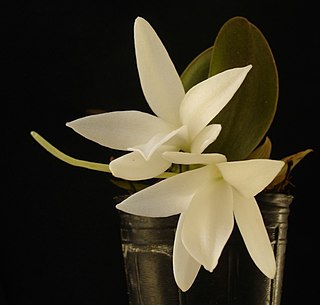
Aerangis, abbreviated as Aergs in horticultural trade, is a genus of the Orchid family (Orchidaceae). The name of this genus has been derived from the Greek words 'aer' (air) and 'angos' (urn), referring to the form of the lip. It is the type genus of the subtribe Aerangidinae, which has recently been subsumed in the subtribe Angraecinae. Approximately 50 species in this genus are known mostly from tropical Africa, but also from the Comoro Islands, Madagascar and Sri Lanka.

Picris (oxtongues) is a genus of flowering plants in the family Asteraceae described as a genus by Linnaeus in 1753.

Kniphofia is a genus of perennial flowering plants in the family Asphodelaceae, first described as a genus in 1794. Species are native to Africa. Common names include tritoma, red hot poker, torch lily and poker plant.
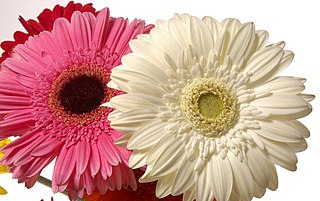
Gerbera L. is a genus of plants in the Asteraceae (Compositae) family. The first scientific description of a Gerbera was made by J. D. Hooker in Curtis's Botanical Magazine in 1889 when he described Gerbera jamesonii, a South African species also known as Transvaal daisy or Barberton daisy. Gerbera is also commonly known as the African daisy.

Gerbera jamesonii is a species of flowering plant in the genus Gerbera belonging to the basal Mutisieae tribe within the large Asteraceae family. It is indigenous to South Eastern Africa and commonly known as the Barberton daisy, the Transvaal daisy, and as Barbertonse madeliefie or Rooigousblom in Afrikaans. It was the first species of Gerbera to be the subject of a scientific description, studied by J. D. Hooker in Curtis's Botanical Magazine in 1889.
Cephalocroton is a genus of plant of the family Euphorbiaceae first described as a genus in 1841. It is native to central, eastern, and southern Africa from Nigeria and Ethiopia south to KwaZulu-Natal.

Cosmos sulphureus is a species of flowering plant in the sunflower family Asteraceae, also known as sulfur cosmos and yellow cosmos. It is native to Mexico, Central America, and northern South America, and naturalized in other parts of North and South America as well as in Europe, Asia, and Australia.

Brachylaena is a genus of flowering plants in the aster, or composite, family, Asteraceae or Compositae. Several are endemic to Madagascar, and the others are distributed in mainland Africa, especially the southern regions.
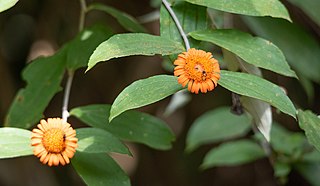
Lycoseris is a genus of Central and South American flowering plants in the family Asteraceae.
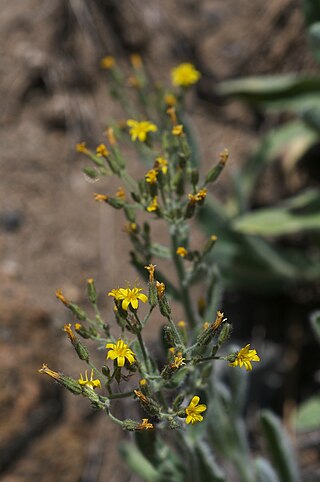
Hieracium horridum, known as the prickly hawkweed or shaggy hawkweed, is a species of plant in the family Asteraceae. It gets its name from the long, dense, shaggy white to brown hairs (trichomes) which cover all of the plant parts of this plant species. The species is native to Oregon, California, and Nevada in the western United States.
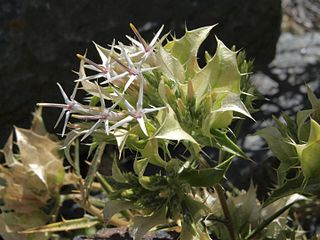
Hecastocleis is a genus of low thorny shrubs with stiff branches, assigned to the daisy family. At the tip of each of the branches, inflorescences are subtended by oval, thorny, whitish to greenish bracts that enclose several flower heads which each contain only one pinkish bud, opening into a white corolla. It contains but one species, Hecastocleis shockleyi, the only representative of the tribe Hecastocleideae, and of the subfamily Hecastocleidoideae. Its vernacular name is prickleleaf. It is confined to the southwestern United States.
Perdicium is a genus of African plants in the tribe Mutisieae within the family Asteraceae.

Gustav Heynhold was a German botanist who worked at the botanic gardens of Dresden and Frankfurt.
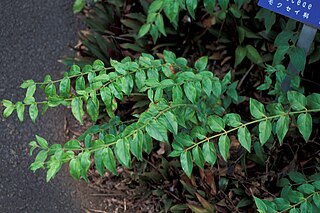
Jasminum multipartitum, the starry wild jasmine, African jasmine, or imfohlafohlane, is a species of jasmine, in the family Oleaceae, that is native to Southern Africa.

Vanilla phaeantha, common name leafy vanilla or oblong-leaved vanilla, is a plant species known to occur in the wild only on the islands of Trinidad and Cuba, and also in Collier County, Florida. It occurs in cypress swamps and hammocks at elevations of less than 20 m.
Chaptalia albicans, the white sunbonnet, is a plant species native to Mexico, Central America and the West Indies. It is known from Jamaica, Cuba, Guatemala, Belize, Honduras, southern Florida, the Bahamas, Hispaniola, Puerto Rico, San Luis Potosí, Veracruz, Yucatán, Campeche and Chiapas.

Askidiosperma is a group of plants in the Restionaceae described as a genus in 1850. The entire genus is endemic to Cape Province in South Africa.
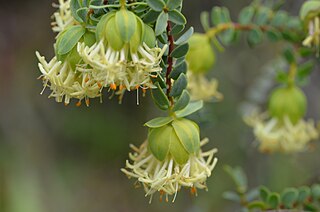
Pimelea sulphurea, commonly known as yellow banjine, is a species of flowering plant in the family Thymelaeaceae and is endemic to the south-west of Western Australia. It is an erect, spindly or open shrub with narrowly elliptic to more or less round leaves, and compact heads of pendulous, yellow flowers surrounded by 3 or more pairs of green to yellowish involucral bracts.

Hedbergia is a monotypic genus of flowering plants, initially classified in Scrophulariaceae, and now within the broomrape family Orobanchaceae. It contains a unique species, Hedbergia abyssinica. It is an afromontane genus, widespread in grasslands and scrubs of the mountains of tropical Africa, and known from Ethiopia, Zaire, Uganda, Kenya, Tanzania, Malawi, Nigeria, and Cameroons.
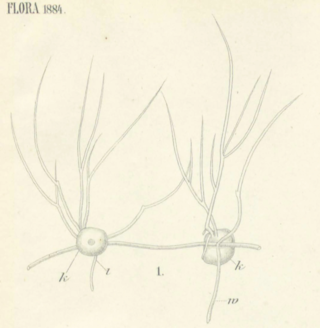
Tetramyxa is a cercozoan protist, member of the plasmodiophores, parasite of several flowering plants. It was first described by Karl von Goebel in 1884, in his work Flora. The genus is characterized by the appearance of resting spores in groups of four.



















